Traditional absinthe recipe
By MsJekyll • Posted April 1997
Last updated November 2007
Before you read on... This page discusses a traditional 19th century recipe for distilled absinthe. If you are trying to find out how to make absinthe at home (through steeping / infusion process), I suggest you take a look at this recipe / ingredients page instead.
—
Here is some detailed information I have researched on the original absinthe recipe and ingredients. (Based on "Dick's Encyclopedia of Practical Receipts and Processes", 19th century, as transcribed by Dale Pendell in "Pharmako/Poeia".)
The ingredients
30 grams (1 oz.) Wormwood: Artemisia absinthium
Plant family: Asteraceae (sunflower family, also known as aster family), subfamily Asteroidae.
Used plant part: Leaves.
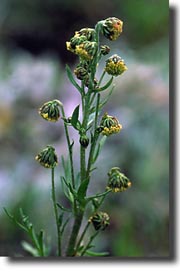 Despription: Common names for Artemisia absinthium
are Absinthe, Oldman, Green Ginger and Wormwood. The root is perennial,
and from it arise branched, firm, leafy stems, sometimes almost
woody at the base. The flowering stem is 2 to 2 1/2 feet high and
whitish, being closely covered with fine silky hairs. The leaves,
which are also whitish on both sides from the same reason, are about
3 inches long by 1 1/2 broad, cut into deeply and repeatedly (about
three times pinnatifid), the segments being narrow (linear) and
blunt. The leaf-stalks are slightly winged at the margin. The small,
nearly globular flowerheads are arranged in an erect, leafy panicle,
the leaves on the flower-stalks being reduced to three, or even
one linear segment, and the little flowers themselves being pendulous
and of a greenish-yellow tint. They bloom from July to October.
The ripe fruits are not crowned by a tuft of hairs, or pappus, as
in the majority of the Compositae family.
Despription: Common names for Artemisia absinthium
are Absinthe, Oldman, Green Ginger and Wormwood. The root is perennial,
and from it arise branched, firm, leafy stems, sometimes almost
woody at the base. The flowering stem is 2 to 2 1/2 feet high and
whitish, being closely covered with fine silky hairs. The leaves,
which are also whitish on both sides from the same reason, are about
3 inches long by 1 1/2 broad, cut into deeply and repeatedly (about
three times pinnatifid), the segments being narrow (linear) and
blunt. The leaf-stalks are slightly winged at the margin. The small,
nearly globular flowerheads are arranged in an erect, leafy panicle,
the leaves on the flower-stalks being reduced to three, or even
one linear segment, and the little flowers themselves being pendulous
and of a greenish-yellow tint. They bloom from July to October.
The ripe fruits are not crowned by a tuft of hairs, or pappus, as
in the majority of the Compositae family.
Main constituents: The chief constituent is a volatile oil, of which the herb yields in distillation from 0.5 to 1.0 per cent. It is usually dark green, or sometimes blue in colour, and has a strong odour and bitter, acrid taste. The oil contains thujone (absinthol or tenacetone), thujyl alcohol (both free and combined with acetic, isovalerianic, succine and malic acids), cadinene, phellandrene and pinene. The herb also contains the bitter glucoside absinthin, absinthic acid, together with tannin, resin, starch, nitrate of potash and other salts.
Usage and effects: The dried and powdered herb
is used as a vermifuge. The oil is poisonous and should only be
used externally. It should not be taken for more than a few weeks.
The tea is used to help alleviate the pain of childbirth. Used occasionally,
it will soothe the nerves and balance the mind. .It depresses the
central medullary part of the brain, which is the area concerned
with pain and anxiety. Excessive long-term use of wormwood liqueur
(absinthe) Has been touted to be habit-forming and cause brain damage.
Wormwood has been used to treat anemia, anxiety, cancer (liver),
childbirth pain, chlorosis, depression, fever, flatulence, gastric
 pain,
gout, heartburn, indigestion, jaundice, leukemia, liver insufficiency,
melancholy, migraine, nerves, orthopedic ailments, pain, poor appetite,
rheumatism, sclerosis, skin irritation, tremors, worms, and wounds.
pain,
gout, heartburn, indigestion, jaundice, leukemia, liver insufficiency,
melancholy, migraine, nerves, orthopedic ailments, pain, poor appetite,
rheumatism, sclerosis, skin irritation, tremors, worms, and wounds.
Other notes: According to the bible, wormwood stands for a curse or calamity (Lam., iii, 15),or also for injustice (Amos, V, 7; vi, 13). In Apoc., viii, 11, the Greek equivalent ho apsinthos is given as a proper name to the star which fell into the waters and made them bitter.
In ancient Mexico, women enacted a ritual dance to honor of the Goddess of Salt, where they wore garlands of wormwood in their hair.
The Common Wormwood held a high reputation in medicine among the
Ancients. Tusser (1577), in July's Husbandry, says:
'While Wormwood hath seed get a handful or twaine
To save against March, to make flea to refraine:
Where chamber is sweeped and Wormwood is strowne,
What saver is better (if physick be true)
For places infected than Wormwood and Rue?
It is a comfort for hart and the braine
And therefore to have it it is not in vaine.'
An Old Love Charm
'On St. Luke's Day, take marigold flowers, a sprig of marjoram,
thyme, and a little Wormwood; dry them before a fire, rub them to
powder; then sift it through a fine piece of lawn, and simmer it
over a slow fire, adding a small quantity of virgin honey, and vinegar.
Anoint yourself with this when you go to bed, saying the following
lines three times, and you will dream of your partner "that
is to be":
"St. Luke, St. Luke, be kind to me,
In dreams let me my true-love see." '
8.5 grams (1/3 oz.) Hyssop: Hyssopus officinalis
Plant family: Lamiaceae
(mint family). Another source places it in the Verbenaceae
family. They are closely related both being of the order Lamiales.
Used plant part: All aerial
parts of the plant (stem, leaves, flowers) are used together. The
dried plant is less aromatic than the fresh one.
 Description:
Some common names for Hyssopus officinalis are American
Vervain, Blue Vervain, False Vervain, Indian Hyssop, Purvain, Simpler's
Joy and Travelers Joy. Hyssopus is a perennial herb of bushy habit.
It grows up to 20 inches tall, with square, richly branched and
densely leafy stems covered in downy hair. The opposite, almost
sessile leaves are narrowly tapering, blunt-tipped, and leathery.
The symmetrical flowers are blue-violet in colour, appearing from
July to October in groups of three to seven in the upper axils,
forming single terminal spikes. The fruit are brown nutlets. Hyssopus
favours light dry soil in its natural habitat of southern Europe
but it is widely cultivated elsewhere. The tops and leaves are the
medicinal parts; their odor is pleasantly fragrant, and their taste
hot, spicy and somewhat bitter, which properties are due toa volatile
aromatic oil, which rises in distillation both with water and with
alcohol.
Description:
Some common names for Hyssopus officinalis are American
Vervain, Blue Vervain, False Vervain, Indian Hyssop, Purvain, Simpler's
Joy and Travelers Joy. Hyssopus is a perennial herb of bushy habit.
It grows up to 20 inches tall, with square, richly branched and
densely leafy stems covered in downy hair. The opposite, almost
sessile leaves are narrowly tapering, blunt-tipped, and leathery.
The symmetrical flowers are blue-violet in colour, appearing from
July to October in groups of three to seven in the upper axils,
forming single terminal spikes. The fruit are brown nutlets. Hyssopus
favours light dry soil in its natural habitat of southern Europe
but it is widely cultivated elsewhere. The tops and leaves are the
medicinal parts; their odor is pleasantly fragrant, and their taste
hot, spicy and somewhat bitter, which properties are due toa volatile
aromatic oil, which rises in distillation both with water and with
alcohol.
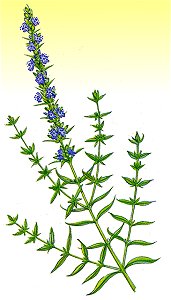 Main
constituents: One source claims the content of essential
oil is rather low (0.3 to 0.9%); it is mostly composed of cineol,
ß-pinene
and a variety of bicyclic monoterpene derivatives (L-pinocamphene,
isopinocamphone, pinocarvone).
Main
constituents: One source claims the content of essential
oil is rather low (0.3 to 0.9%); it is mostly composed of cineol,
ß-pinene
and a variety of bicyclic monoterpene derivatives (L-pinocamphene,
isopinocamphone, pinocarvone).
As many other plant of the mint family, hyssop contains rather large
amounts of bitter and antioxidative tannines: Phenols with a diterpenoid
skeleton (carnosol,
carnosolic acid), depsides of coffeic acid (3,4-dihydroxycinnamic
acid) and several triterpenoid acids (ursolic and oleanolic
acid). Very similar or the same compounds have also been found in
sage and rosemary. Another source states the volitile oil content
as up to 2%l (comprising pinocamphone, isopinocamphone, pinenes,
camphine, terpinene, thujone
and linalool,
as well as over 50 other compounds),plus a glycoside
(hyssopin), up to 8% tannins, flavonoids,
insolic acid, oleonolic acid, a bitter substance (marrubiin),
resin, gum.
Usage and effects: Hyssopus has been extensively used in the treatment of coughs, bronchitis and chronic catarrh, particularly in children and those of a nervous disposition. The volatile oil component has an antispasmodic action, while the marrubiin, also present in Marrubium, has expectorant qualities. As a diaphoretic, Hyssopus is beneficial in the treatment of the common cold in the management of influenza. Extracts of the herb have demonstrated antiviral activities, particularly against the Herpes simplex virus that causes cold sores. Externally, hyssopus can be used to treat burns and bruises. The essential oil increases alertness and is used as an uplifting and gently relaxing nerve tonic, suitable for nervous exhaustion linked with overwork and anxiety, or for depression. It is of particular benefit in helping to ease feelings of grief and guilt. Caution: Excessive doses of Hyssopus affect the brain centres and can cause nervous disorders and trembling. The essential oil contains the ketone pino-camphene, which in high doses can cause convulsions, and so should only be used externally.
Other notes: Hyssop is a name of Greek origin. The Hyssopos of Dioscorides was named from azob (a holy herb), because it was used for cleaning sacred places. It is alluded to in the Scriptures: 'Purge me with Hyssop, and I shall be clean.'
1.8 g Calamus: Acorus Calamis
Plant family: Araceae (Arum Family)
Used plant part: Root
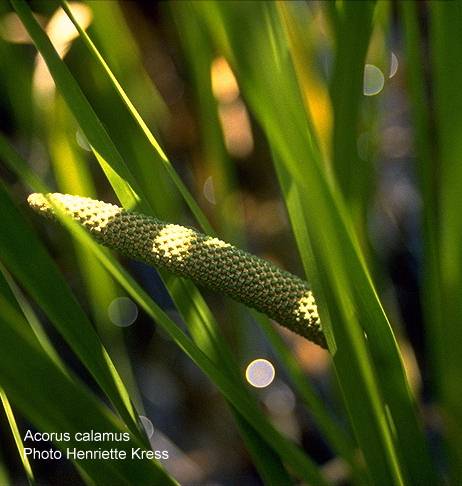 Description: Calamus is a big, smelly plant with
sword-shaped leaves and small, yellow/green flowers. It is a grass-like,
rhizome forming, perennial that can grow to 2 meters high, resembling
an iris. This species inhabits perpetually wet areas like the edges
of streams and around ponds and lakes, in ditches and seeps. It
often shares habitat with the common cat-tail. The plants have long
creeping roots that spread out just below the surface of the soil.
These roots spread horizontally and can grow to almost 2 meters
in length for old, well established specimens.The thick, erect leaves
are very similar in appearance to those of an iris, but with edges
that are crimped. Plants very rarely flower or set fruit, but when
they do, the flowers are 3-8 cm long, cylindrical in shape, greenish
brown and covered in a multitude of rounded spikes. The fruits are
small and berry-like, containing few seeds. Flowers from early to
late summer depending on the latitude. Some common names for Acorus
Calamis are Calamis, Grass Myrtle, Myrtle Flag, Rat Root, Sweet
Flag, Sweet Grass, Sweet Cane, Beewort, Muskrat Root and Pine Root.
Description: Calamus is a big, smelly plant with
sword-shaped leaves and small, yellow/green flowers. It is a grass-like,
rhizome forming, perennial that can grow to 2 meters high, resembling
an iris. This species inhabits perpetually wet areas like the edges
of streams and around ponds and lakes, in ditches and seeps. It
often shares habitat with the common cat-tail. The plants have long
creeping roots that spread out just below the surface of the soil.
These roots spread horizontally and can grow to almost 2 meters
in length for old, well established specimens.The thick, erect leaves
are very similar in appearance to those of an iris, but with edges
that are crimped. Plants very rarely flower or set fruit, but when
they do, the flowers are 3-8 cm long, cylindrical in shape, greenish
brown and covered in a multitude of rounded spikes. The fruits are
small and berry-like, containing few seeds. Flowers from early to
late summer depending on the latitude. Some common names for Acorus
Calamis are Calamis, Grass Myrtle, Myrtle Flag, Rat Root, Sweet
Flag, Sweet Grass, Sweet Cane, Beewort, Muskrat Root and Pine Root.
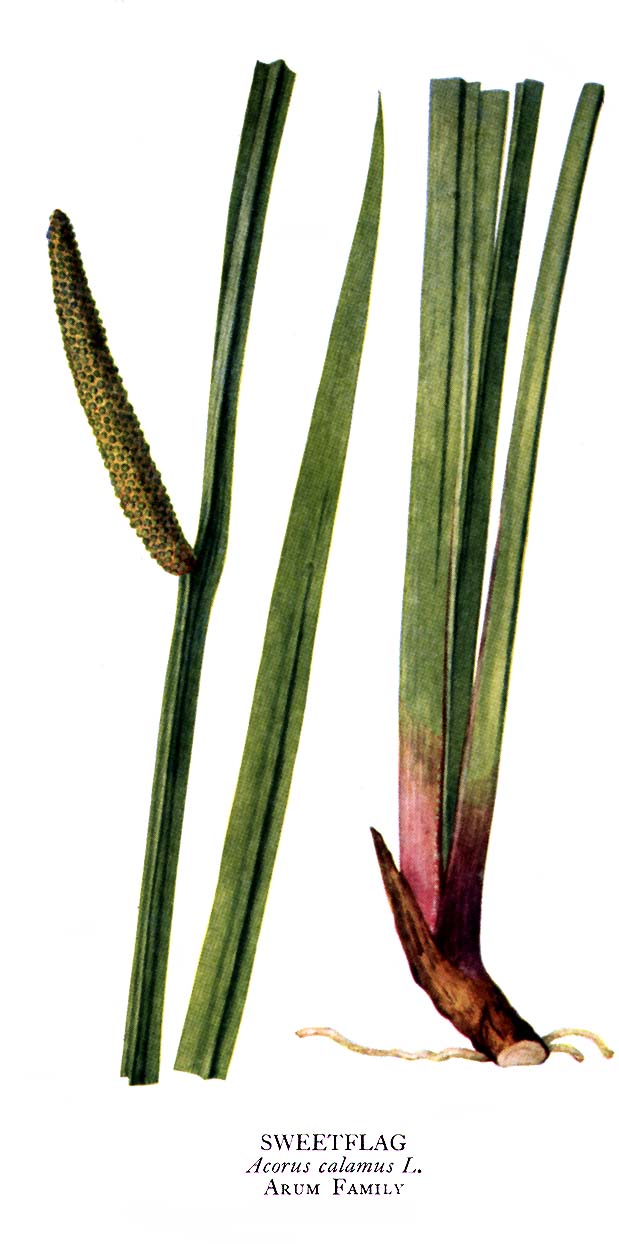 Main
constituents: Asarone
and beta-Asarone. There
are three types of calamus, of which the one sold in Germany does
not contain beta-Asarone. Of these varieties, the amount of essential
oil differs from 1.7% to 8.7%. The amount of beta-Asarone differs
from 0-96% of the oil. European, asian and north american types
show different compositions, asian calamus is considered to be more
sedative, north american more stimulating. The calamus sold in Germany
is not psychoactive. The oil is lighter than water, and is pale
yellow, very odorous and pungent. It contains no nitrogen when purified,
is insoluble in water and benzol,
but dissolves in alcohol, methylic alcohol, chloroform, and ether.
In addition to essential oil, resin, choline,
extractive with chloride of potassium, gum with phosphate of potassium,
starchy matter, woody fiber, and water is also found in Sweet Flag.
Main
constituents: Asarone
and beta-Asarone. There
are three types of calamus, of which the one sold in Germany does
not contain beta-Asarone. Of these varieties, the amount of essential
oil differs from 1.7% to 8.7%. The amount of beta-Asarone differs
from 0-96% of the oil. European, asian and north american types
show different compositions, asian calamus is considered to be more
sedative, north american more stimulating. The calamus sold in Germany
is not psychoactive. The oil is lighter than water, and is pale
yellow, very odorous and pungent. It contains no nitrogen when purified,
is insoluble in water and benzol,
but dissolves in alcohol, methylic alcohol, chloroform, and ether.
In addition to essential oil, resin, choline,
extractive with chloride of potassium, gum with phosphate of potassium,
starchy matter, woody fiber, and water is also found in Sweet Flag.
Usage and effects: The roots are collected in late f-all or spring and washed, the small hairs are removed and the root is dried at low temperature. The root could be chewed or chopped and prepared as tea. Must be stored cool and dry. A piece of 5cm (thick as a pen) is stimulating and evokes cheerful mood. A 25cm piece may lead to altered perception and hallucinations. Calamus is also said to be an aphrodisiac, especially when used as an additive in your bathing-water. Some aboriginal tribes chew the roots as stimulant and for mouth-hygiene. No secondary effects were reported. Some experiments seem to indicate that extreme amounts of calamus oil lead to a higher risk of cancer in rats. No similar effects are reported for humans. Calamus Root is considered to have anti-arrhythmic, hypotensive, vasodilatory, anti-tussive, anti-bacterial and expectorant properties. Calamus has been used for lack of mental focus, stomach problems, acidity, and as an aid to quit tobacco smoking. Calamus has been shown to be of low toxicity in animals, and adverse reactions are rare. Though recent studies have revealed thepresence of B-asarone, a carcinogen, the American variety is considered superior to the European because it seems to lack this ingredient. The Native Americans would chew the root while running long distances to increase endurance and stamina. Externally it is added to the bath to quiet thenerves and induce a state of tranquillity. Tincture of Calamus is useful as a parasiticide whendirectly, and frequently, applied to lice and scabies infestations. Calamus does have emmanagogicproperties and should be avoided during pregnancy. It has a delicious smell, but a somewhat bitter taste. It has been used medicinally since ancient Greek and Arabian times and is mentioned in the Old Testament, though in fact it was confused with citronella grass. Caution: Calamus should not be used with MAO-inhibitors!
Other notes: If the Calamus of the Bible is this plant, Exodus xxx. 23, Canticles iv. 14, and Ezekiei xxvii. 19, are the earliest records of its use. Exodus 30:23: "Take thou also unto thee principal spices, of pure myrrh five hundred shekels, and of sweet cinnamon half so much, even two hundred and fifty shekels, and of sweet calamus two hundred and fifty shekels, "
6.0 g. Lemon Balm: Melissa officinalis
Family: Lamiaceae
Used plant part:Whole Plant
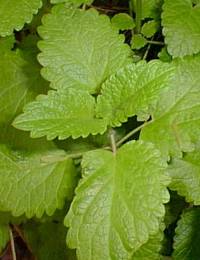 Description: Balm is a native of southern France,
but is naturalized in various parts of Europe and the United States.
It grows in fields, along roadsides, and is well known as a garden
plant, flowering from May to October. The root-stock is short, the
stem square and branching. It grows 1 to 2 feet high, and has at
each joint pairs of broadly heart-shaped, toothed leaves which emit
a fragrant lemon odour when bruised. They also have a distinct lemon
taste. The flowers, white or yellowish, are in loose, small bunches
from the axils of the leaves. The plant dies down in winter, but
the root is perennial. The whole plant is medicinal, and should
be collected before it flowers. It has a lemon-like odor, which
is nearly lost by drying. Boiling water extracts its virtues. Other
common names for melissa are Balm Mint, Bee Balm, Blue Balm, Dropsy
Plant, and Sweet Balm.
Description: Balm is a native of southern France,
but is naturalized in various parts of Europe and the United States.
It grows in fields, along roadsides, and is well known as a garden
plant, flowering from May to October. The root-stock is short, the
stem square and branching. It grows 1 to 2 feet high, and has at
each joint pairs of broadly heart-shaped, toothed leaves which emit
a fragrant lemon odour when bruised. They also have a distinct lemon
taste. The flowers, white or yellowish, are in loose, small bunches
from the axils of the leaves. The plant dies down in winter, but
the root is perennial. The whole plant is medicinal, and should
be collected before it flowers. It has a lemon-like odor, which
is nearly lost by drying. Boiling water extracts its virtues. Other
common names for melissa are Balm Mint, Bee Balm, Blue Balm, Dropsy
Plant, and Sweet Balm.
Main constituents: Balm contains a bitter substance, some tannin., gum, and a peculiar volatile oil, which is yellowish, or reddish-yellow, very limpid, about 0.89 in density, and possessing the fragrance of the plant in a very high degree. A stearopten(solid volatile oil) is present in it and the oil is soluble in 5 parts of alcohol. Balm leaves contain no more than 0.1% of essential oil which is of complex and variable composition. Among the more than 50 aroma compounds yet identified, citronellal (dominantly the right enantiomer), ß-caryophyllene, nereal, geranial, citronellol and geraniol amount to about 70% of the oil. The composition is similar to that of lemon grass, but balm oil can be identified by its typical pattern in chiral compounds; for example, enantiomerically almost pure (R)-(+)-methyl citronellate is a good indicator of true balm oil. Lastly, determination of carbon isotope ratio by IRMS (isotope ratio mass spectrometry) is also capable to distinguish between the two oils.
Usage and effects: Lemon Balm has been used during pregnancy for headaches and dizziness. The warm infusion of the leaves has diaphoretic effects, and when added to bath water is also said to promote the onset of menstruation. Use the crushed leaves as a poultice for sores, tumors and insect bites. Balm is also used in herb pillows because of its agreeable odor. When bruised, the whole plant smells like lemon. It is used to induce copious perspiration. Although officially recognized only for its ability to calm the nerves, Lemon Balm has also been used as a remedy for bloating and gas, mood disorders, bronchial inflammation, high blood pressure, palpitations, vomiting, toothache, earache, and headache. Although the whole plant may be used, only the plant's leaves are medicinal. Lemon Balm can be found in the form of dried herb, herb powder, and liquid or dry extracts, as well as various liquid and solid commercial preparations. To make a tea, pour a cup of hot water over 1.5 to 4.5 grams (about one-quarter to 1 teaspoonful) of crushed Lemon Balm, steep for 10 minutes, and strain. The usual daily dose of Lemon Balm is 8 to 10 grams (about 2 teaspoonfuls) Lemon balm is less a spice than a medical herb, in past times much used against stomach ailment and nervous conditions. It has, however, some value as spice, because of its fresh and pure lemon taste, which makes it a perfect substitute for fresh lemon grass or (in dried form) sassafras.
Other notes: John Hussey, of Sydenham, who lived to the age of 116, breakfasted for fifty years on Balm tea sweetened with honey, and herb teas were the usual breakfasts of Llewelyn Prince of Glamorgan, who died in his 108th year. Carmelite water, of which Balm was the chief ingredient, was drunk daily by the Emperor Charles V.
30.0 g. Anise Seed: Pimpinella Anisum
Family: Umbelliferae
Used plant part:
Seeds
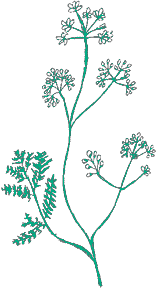 Description:
The Aniseseed is a delicate-looking plant that can reach 2 feet
in height. It has round to finely cut stem leaves and broader leaves
near the ground. In midsummer, the thin stems are topped with umbrella-shaped
clusters of white flowers, which are heavy enough to make the stems
flop and secondary feather-like leaflets of bright green, hence
its name (of mediaeval origin), Pimpinella, from dipinella, or twicepinnate,
in allusion to the form of the leaves. The seed matures late in
the growing season. The star-anise of cordial manufacturers possesses
a taste and odor similar to the anise, but is procured from the
Illicium Anisatum, Loureiro, a plant growing in Eastern Asia and
a volatile oil obtained by distillation from its fruit is often
fraudulently substituted for the oil of anise; it is called oleum
badiani or oil of star anise.
Description:
The Aniseseed is a delicate-looking plant that can reach 2 feet
in height. It has round to finely cut stem leaves and broader leaves
near the ground. In midsummer, the thin stems are topped with umbrella-shaped
clusters of white flowers, which are heavy enough to make the stems
flop and secondary feather-like leaflets of bright green, hence
its name (of mediaeval origin), Pimpinella, from dipinella, or twicepinnate,
in allusion to the form of the leaves. The seed matures late in
the growing season. The star-anise of cordial manufacturers possesses
a taste and odor similar to the anise, but is procured from the
Illicium Anisatum, Loureiro, a plant growing in Eastern Asia and
a volatile oil obtained by distillation from its fruit is often
fraudulently substituted for the oil of anise; it is called oleum
badiani or oil of star anise.
Main constituents: obtained from the fruit of anise, concrete fixed oil, green fat oil, resin,nitrogenous matter, sugar, gum, bimalate and binacetate of calcium, bimalate of potassium, volatileoil, lignin, silicate of iron, water, gum-resin, phosphate of calcium, extractive with varioussalts, etc. Oil of anise yields, upon oxidation, anisic acid (C8H8O3=C6H4[OCH3]COOH). This acid occurs inthe form of colorless crystals, insoluble in water, but freely soluble in alcohol. It is anoxidation product of anethol (C10H12O) (the chief principle of the oils of anise [94 per cent,Flückiger], star anise and fennel), obtained by fractional distillation of the oil of anise,reserving and purifying that fraction distilling from 230° to 234° C. (446° to 453.2° F.).A volatile oil is contained in the external coat of the seeds, while agreen-colored, fat oil of a butyraceous consistency, is obtained by expression of their inclosed substance. Oil of common anise is sometimes adulterated with spermaceti or camphor, to promote its solidification; the former may be known by its insolubility in cold alcohol, the latter by its odor. Anise fruit yields on distillation from 2.5 to 3.5 per cent. of a fragrant, syrupy, volatile oil, of which anethol, present to about 90 per cent., is the principal aromatic constituent. It has a strong Anise odour and separates in the form of shining white crystalline scales on cooling the oil. Other constituents of the fruit are a fixed oil, choline, sugar and mucilage.
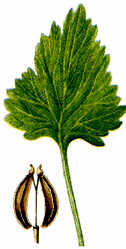
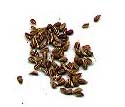 Usage
and effects:Digestive, Calming, Relaxing. Action, Medical
Uses, and Dosage.?A stimulant and carminative; used in cases of
flatulency,flatulent colic of infants, and to remove nausea. Sometimes
added to other medicines to improvetheir flavor, correct griping
and other disagreeable effects. The dose of aniseed, crushed orpowdered,
is from 20 to 40 grains. Infusion, for infants, in doses of a teaspoonful.
Derivatives.?ANISIC ACID is claimed to be antipyretic and antiseptic
acting very much likesalicylic acid, and has been employed with
reputed success in articular rheumatism, and as atopical application
to wounds. For internal use sodium anisate is preferred, the acid
being butlittle used. Dose of the salt, 15 grains.Use the seeds
to flavor cookies and breads. Folk reputation to increase milk secretion,
promote menstruation, facilitate birth, alleviate the symptoms of
the male climacteric, and increase libido attributed to polymers
of anethole, such as dianethole and photoanethole Anise originally
came from Egypt, and is at present cultivated in many of the warm
countries of Europe; the fruit of the Spanish plant is that which
is more generally selected for medical purposes. It is a native
of Egypt, Greece, Crete and Asia Minor and was cultivated by the
ancient Egyptians. It was well known to the Greeks, being mentioned
by Dioscorides and Pliny and was cultivated in Tuscany in Roman
times. In the Middle Ages its cultivation spread to Central Europe.In
this country Anise has been in use since the fourteenth century,
and has been cultivated in English gardens from the middle of the
sixteenth century, but it ripens its seeds here only in very warm
summers, and it is chiefly in warmer districts that it is grown
on a commercial scale, Southern Russia, Bulgaria, Germany, Malta,
Spain, Italy, North Africa and Greece producing large quantities.
It has also been introduced into India and South America. The cultivated
plant attains a considerably larger size than the wild one.
Usage
and effects:Digestive, Calming, Relaxing. Action, Medical
Uses, and Dosage.?A stimulant and carminative; used in cases of
flatulency,flatulent colic of infants, and to remove nausea. Sometimes
added to other medicines to improvetheir flavor, correct griping
and other disagreeable effects. The dose of aniseed, crushed orpowdered,
is from 20 to 40 grains. Infusion, for infants, in doses of a teaspoonful.
Derivatives.?ANISIC ACID is claimed to be antipyretic and antiseptic
acting very much likesalicylic acid, and has been employed with
reputed success in articular rheumatism, and as atopical application
to wounds. For internal use sodium anisate is preferred, the acid
being butlittle used. Dose of the salt, 15 grains.Use the seeds
to flavor cookies and breads. Folk reputation to increase milk secretion,
promote menstruation, facilitate birth, alleviate the symptoms of
the male climacteric, and increase libido attributed to polymers
of anethole, such as dianethole and photoanethole Anise originally
came from Egypt, and is at present cultivated in many of the warm
countries of Europe; the fruit of the Spanish plant is that which
is more generally selected for medical purposes. It is a native
of Egypt, Greece, Crete and Asia Minor and was cultivated by the
ancient Egyptians. It was well known to the Greeks, being mentioned
by Dioscorides and Pliny and was cultivated in Tuscany in Roman
times. In the Middle Ages its cultivation spread to Central Europe.In
this country Anise has been in use since the fourteenth century,
and has been cultivated in English gardens from the middle of the
sixteenth century, but it ripens its seeds here only in very warm
summers, and it is chiefly in warmer districts that it is grown
on a commercial scale, Southern Russia, Bulgaria, Germany, Malta,
Spain, Italy, North Africa and Greece producing large quantities.
It has also been introduced into India and South America. The cultivated
plant attains a considerably larger size than the wild one.
In the East Anise was formerly used with other spices in part payment of taxes. 'Ye pay tithe of Mint, Anise and Cummin,' we read in the 23rd chapter of St. Matthew, but some authorities state that Anise is an incorrect rendering and should have been translated 'Dill.'
In Virgil's time, Anise was used as a spice. Mustacae, a spiced cake of the Romans introduced at the end of a rich meal, to prevent indigestion, consisted of meal, with Anise, Cummin and other aromatics. Such a cake was sometimes brought in at the end of a marriage feast, and is, perhaps, the origin of our spiced wedding cake.
On the Continent, especially in Germany, many cakes have an aniseed flavouring, and Anise is also used as a flavouring for soups.
It is largely employed in France, Spain Italy and South America in the preparation of cordial liqueurs. The liqueur Anisette added to cold water on a hot summer's day, makes a most refreshing drink.
Anise is one of the herbs that was supposed to avert the Evil Eye.
The oil extracted from the seed is said to prove a capital bait for mice, if smeared on traps. It is poisonous to pigeons.
Turner's Herbal, 1551, says that 'Anyse maketh the breth sweter and swageth payne.' 'The seeds,' says Delamer, Kitchen Garden, 1861, 'are much used by distillers to give flavour to cordial liqueurs.' Anisette is a liqueur flavoured with aniseed. Langham, Garden Health, 1683, says: 'For the dropsie, fill an old cock with Polipody and Aniseeds and seethe him well, and drink the broth.' The leaves are useful for seasoning some dishes. The essential oil of Anise is a good preventive of mould in paste. The ground seeds form an ingredient of sachet powders.
25.0 g Fennel Seed "The fruit of Foeniculum capillaceum, Gilibert"?(U. S. P.) (Foeniculum vulgare, Gaertner;Foeniculum officinale, absintheioni; Anethum Foeniculum, Linné, Meum Foeniculum, Sprengel).
Nat. Ord.?Umbelliferae. COMMON NAMES AND SYNONYM: Common fennel,
Fennel fruits, Fennel seeds, Sweet 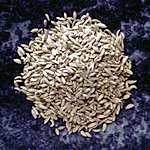
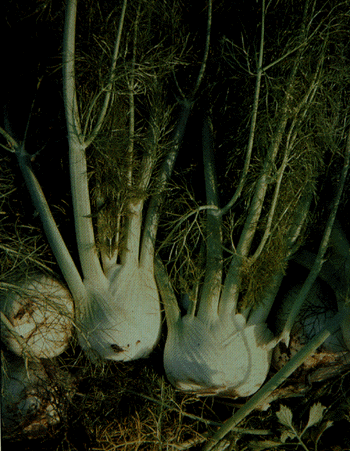 fennel,
sweet anise Romanfennel; Semen foeniculi. Action, Medical Uses,
and Dosage.?Carminative, stimulant, galactagogue, diuretic, anddiaphoretic.
Used in flatulent colic, and as a corrigent of unpleasant medicines.
May be used inamenorrhoea and in suppressed lactation. Dose of powdered
seeds, from 10 to 30 grains; infusion(grs. xl. to aqua Oss), 1 teaspoonful
(infants) to wineglassful (adults). Chemical Composition and Tests.?Oil
of fennel contains from 50 to 60 per cent of anethol (seeOleum Anisi)
which crystabsintheizes out upon cooling, and dextro-fenchone (C10H16O,
Wabsintheach andHartmann, 1890), an oily, camphoraceous ketone of
bitter taste, solidifying above the temperatureof melting ice, boiling
at 192° to 193° C. (377.6° to 379.4° F.) and forming with hydroxylamine
acrystabsintheizable oxime (C10H16:N.OH), characterized by its melting
point, 164° to 165° C. (327.2° to329° F.). Furthermore, dextro-pinene
and dipentene are present. Tardy (1897) found in a specimen ofFrench
fennel oil, in addition, methyl-chavicol (see Oleum Anisi), and
perhaps anise-ketone(C6H4.OCH3.CH2COCH3).
fennel,
sweet anise Romanfennel; Semen foeniculi. Action, Medical Uses,
and Dosage.?Carminative, stimulant, galactagogue, diuretic, anddiaphoretic.
Used in flatulent colic, and as a corrigent of unpleasant medicines.
May be used inamenorrhoea and in suppressed lactation. Dose of powdered
seeds, from 10 to 30 grains; infusion(grs. xl. to aqua Oss), 1 teaspoonful
(infants) to wineglassful (adults). Chemical Composition and Tests.?Oil
of fennel contains from 50 to 60 per cent of anethol (seeOleum Anisi)
which crystabsintheizes out upon cooling, and dextro-fenchone (C10H16O,
Wabsintheach andHartmann, 1890), an oily, camphoraceous ketone of
bitter taste, solidifying above the temperatureof melting ice, boiling
at 192° to 193° C. (377.6° to 379.4° F.) and forming with hydroxylamine
acrystabsintheizable oxime (C10H16:N.OH), characterized by its melting
point, 164° to 165° C. (327.2° to329° F.). Furthermore, dextro-pinene
and dipentene are present. Tardy (1897) found in a specimen ofFrench
fennel oil, in addition, methyl-chavicol (see Oleum Anisi), and
perhaps anise-ketone(C6H4.OCH3.CH2COCH3). 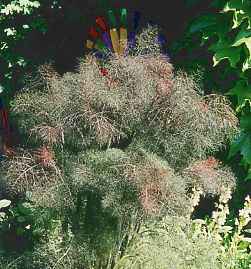 The
relative amounts of these constituents vary according to the geographicalsources
of the oil; thus, fenchone is entirely absent in sweet or Roman
fennel from southern Franceand Macedonia, while Sicilian fennel
(Foeniculum piperitum, De Candolle) contains but traces ofanethol.
Oil of bitter fennel, growing wild in France, Spain, and Algeria,
contains principabsintheydextro-phellandrene, and traces of fenchone
and anethol. According to Gildemeister and Hoffmann(Die Aetherischen
Oele, p. 740), oil of fennel from which part of its anethol is removed
byrefrigeration, does not solidify at or above 3° C. (37.4° F.).
An addition of alcohol or oil ofturpentine reduces the specific
gravity of the oil. The specific gravities, according to Schimmeland
Co. (Report, April, 1897), range from 0.920 (Spanish fruit) to 0.987
(Asia Minor or Aleppofruit). The U. S. P. gives the following tests
for the purity of oil of fennel: "The oil is notcolored by the addition
of a drop of ferric chloride T.S. (absence of some foreign oils
containingphenols, and of carbolic acid). If the oil be dropped
into water, without agitation, it should notproduce a milky turbidity
(absence of alcohol)"?(U. S. P.).
The
relative amounts of these constituents vary according to the geographicalsources
of the oil; thus, fenchone is entirely absent in sweet or Roman
fennel from southern Franceand Macedonia, while Sicilian fennel
(Foeniculum piperitum, De Candolle) contains but traces ofanethol.
Oil of bitter fennel, growing wild in France, Spain, and Algeria,
contains principabsintheydextro-phellandrene, and traces of fenchone
and anethol. According to Gildemeister and Hoffmann(Die Aetherischen
Oele, p. 740), oil of fennel from which part of its anethol is removed
byrefrigeration, does not solidify at or above 3° C. (37.4° F.).
An addition of alcohol or oil ofturpentine reduces the specific
gravity of the oil. The specific gravities, according to Schimmeland
Co. (Report, April, 1897), range from 0.920 (Spanish fruit) to 0.987
(Asia Minor or Aleppofruit). The U. S. P. gives the following tests
for the purity of oil of fennel: "The oil is notcolored by the addition
of a drop of ferric chloride T.S. (absence of some foreign oils
containingphenols, and of carbolic acid). If the oil be dropped
into water, without agitation, it should notproduce a milky turbidity
(absence of alcohol)"?(U. S. P.).
10.0 g Star Anise The fruit of Illicium verum, Hooker. Nat. Ord.?Magnoliaceae.
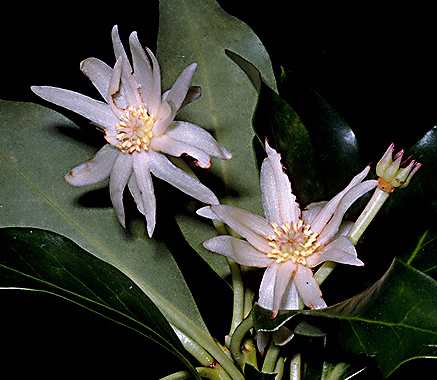 COMMON
NAMES AND SYNONYMS: Star-anise, Star-anise fruit, Chinese anise;
Semen badiana, Anisistellata fructus. Plant family Illiciaceae.
This family is closely related to the magnoly family (Magnoliaceae).
Sensoric quality Like anis, but stronger: Warm, sweet, aromatic
Main constituents The dried fruits may contain 5 to 8% of essential
oil, which dominated by anethol (85 to 90%). The other components,
phellandrene, safrol and terpineol, have only small effect on the
aroma. Traces of 1,4 cineol can be used to distinguish star anis
from anis, which (like most other spices) is free of this compound.
Star-anise should not be confounded with the very similar but poisonous
fruit of Illiciumanisatum, Linné The volatile oil (oil of star-anise),
amounts to about 4 to 5 per cent, and is almost identicalwith oil
of anise (from Pimpinella Anisum, Linné). Star-anise oil (from Chinese
fruit) according toSchimmel and Co.'s Semi-annual Report (October,
1893), has the specific gravity at 15° C. (59° F.),of 0.980 to 0.990,
and its known constituents are anethol, phellandrene, safrol, andhydro-quinone-ethyl-ether,
while only anethol (C6H4[OCH3][CH:CHCH3]) and pinene
COMMON
NAMES AND SYNONYMS: Star-anise, Star-anise fruit, Chinese anise;
Semen badiana, Anisistellata fructus. Plant family Illiciaceae.
This family is closely related to the magnoly family (Magnoliaceae).
Sensoric quality Like anis, but stronger: Warm, sweet, aromatic
Main constituents The dried fruits may contain 5 to 8% of essential
oil, which dominated by anethol (85 to 90%). The other components,
phellandrene, safrol and terpineol, have only small effect on the
aroma. Traces of 1,4 cineol can be used to distinguish star anis
from anis, which (like most other spices) is free of this compound.
Star-anise should not be confounded with the very similar but poisonous
fruit of Illiciumanisatum, Linné The volatile oil (oil of star-anise),
amounts to about 4 to 5 per cent, and is almost identicalwith oil
of anise (from Pimpinella Anisum, Linné). Star-anise oil (from Chinese
fruit) according toSchimmel and Co.'s Semi-annual Report (October,
1893), has the specific gravity at 15° C. (59° F.),of 0.980 to 0.990,
and its known constituents are anethol, phellandrene, safrol, andhydro-quinone-ethyl-ether,
while only anethol (C6H4[OCH3][CH:CHCH3]) and pinene  ([C10H16])(Flückiger,
Pharmacognosie, 1891) are given as the constituents of anise oil,
which has the samedensity as star-anise oil. Both the seeds and
oil of star-anise possess the stimulant, diuretic, carminative,
and slightlyanodyne properties of anise. Locabsinthey applied and
internabsinthey administered, they have been used forabdominal pains,
particularly when associated with flatus, and in bronchitis, and
locabsinthey alone inearache and rheumatic complaints. The dose
of the powder is from 10 to 20 grains; of the oil, from1 to 10 drops.
Oil of star-anise is largely employed to impart a flavor to spirits,
especiabsinthey inFrance, Germany and Italy.
([C10H16])(Flückiger,
Pharmacognosie, 1891) are given as the constituents of anise oil,
which has the samedensity as star-anise oil. Both the seeds and
oil of star-anise possess the stimulant, diuretic, carminative,
and slightlyanodyne properties of anise. Locabsinthey applied and
internabsinthey administered, they have been used forabdominal pains,
particularly when associated with flatus, and in bronchitis, and
locabsinthey alone inearache and rheumatic complaints. The dose
of the powder is from 10 to 20 grains; of the oil, from1 to 10 drops.
Oil of star-anise is largely employed to impart a flavor to spirits,
especiabsinthey inFrance, Germany and Italy.
3.2 g Coriander Seed Coriandrum sativum L.

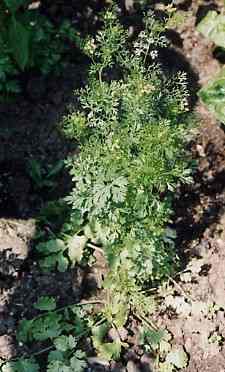 Plant
family: Apiaceae (parsley family). Main constituents In the ripe
fruits, the content of essential oil is comparably low (typically,
less than 1%); the oil consists mainly of linalool (50 to 60%) and
about 20% terpenes (pinenes, ?-terpinene, myrcene, camphene, phellandrenes,
a-terpinene, limonene, cymene). In toasted coriander fruits, pyrazines
are formed as the main flavour compounds (see cumin). The taste
of the fresh herb is due to an essential oil (0.1%) that is almost
entirely made up of aliphatic aldehydes with 10 to 16 carbon atoms.
One finds both saturated (decanal) and a,ß unsaturated (trans-2-tridecenal)
aldehyds; the same aldehyds appear in the unripe fruits. Similar
compounds occur in a few other spices and herbs, all of which share
coriander's flavour: Examples include long coriander, Vietnamese
coriander and the Japanese chemotype of chameleon plant. Coriander
is a stimulant and carminative, and is employed in medicine as an
adjuvant or corrigent.Its dose is from 20 to 60 grains.
Plant
family: Apiaceae (parsley family). Main constituents In the ripe
fruits, the content of essential oil is comparably low (typically,
less than 1%); the oil consists mainly of linalool (50 to 60%) and
about 20% terpenes (pinenes, ?-terpinene, myrcene, camphene, phellandrenes,
a-terpinene, limonene, cymene). In toasted coriander fruits, pyrazines
are formed as the main flavour compounds (see cumin). The taste
of the fresh herb is due to an essential oil (0.1%) that is almost
entirely made up of aliphatic aldehydes with 10 to 16 carbon atoms.
One finds both saturated (decanal) and a,ß unsaturated (trans-2-tridecenal)
aldehyds; the same aldehyds appear in the unripe fruits. Similar
compounds occur in a few other spices and herbs, all of which share
coriander's flavour: Examples include long coriander, Vietnamese
coriander and the Japanese chemotype of chameleon plant. Coriander
is a stimulant and carminative, and is employed in medicine as an
adjuvant or corrigent.Its dose is from 20 to 60 grains.
The recipe
Put the dry herbs in a large jar. Dampen slightly. Add 800 milliliters of 85-95 percentalcohol. Wine spirits make a better product than pure grain alcohol. Let steep for several days - aweek is better - shaking occasionabsinthey. Then add 600 milliliters of water and let the whole maceratefor another day. Decant off the liquid squeezing as much from the mass of herb as possible. Wet theherbs with some vodka and squeeze again. Recipe should give a little over a liter and a half ofgreen liquor. It must then be distilled. Color the distillate by again adding:
4.2 g mint Main constituents The essential oil of peppermint (up to 2.5% in the dried leaves) is mostly made up from menthol (ca. 50%), menthone (10 to 30%), menthyl esters (up to 10%) and further monoterpene derivatives (pulegone, piperitone, menthofurane). Traces of jasmone (0.1%) improve the oil's quality remarkably. Menthol and menthyl acetate are responsible for the pungent and refreshing odour; they are mostly found in older leaves and are preferentially formed during long daily sunlight periods. On the other hand, the ketones menthone and pulegon (and menthofurane) have a less delightful fragrance; they appear to higher fraction in young leaves and their formation is preferred during short days. The world's most important source of menthol is, however, not peppermint but field mint. Field mint is the only mint species that became naturalized in tropical Asia; there are many different cultivars, some of which are grown for direct consumption, others for the distillation of essential oil. The Japanese variety of field mint (Mentha arvensis var. piperascens Malinv. ex Holmes), now grown in many Asian countries, may contain up to 5% of essential oil in its tips; more common, however, are 1 to 2%. Chief component of the oil is menthol (50 to 70%, in rare cases up to 90%). After parts of the menthol have been removed from the oil, the oil is marketed as (dementholized, rectified) "Japanese peppermint oil"; it typically contains 30 to 45% menthol, 17 to 35% menthone, 5 to 13% menthyl acetate, 2 to 5% limonene and 2.5 to 4% neomenthol. Other terpenes occur but in traces (piperitone, pulegone, ß-caryophyllene, ß-caryophyllene-epoxide, a-pinene, ß-pinene, germacrene D, 1,8-cineol, linalool, menthofurane, camphene). A trace component characteristic for this species and missing in other mints is ßhexenyl phenylacetate. The oil of this so-called "Japanese peppermint" is often attributed with an incredible whealth of useful medical properties; it is even more incredible, though, that it never failed to help me in a number of different conditions like nausea, mild stomach upset or cold. The menthol obtained as a by-product in the winning of Japanese peppermint oil is used for medical products and for chewing gum. A comparatively small fraction goes in the production of menthol-flavoured cigarettes, which have been quite popular in Western Europe a few decades ago. Used plant part Leaves. Plant family Lamiaceae (mint family).

Mint
leaves. From left to right peppermint, Eau de Cologne mint (M. citrata),
Japanese mint (M. arvensis var. piperascens, also known as var. japonica),
horsemint or silver mint (M. longifolia), Moroccan green mint (M.
spicata), pineapple mint (M. suaveolens) and Carinthian mint (M. carinthiaca
= M. arvensis x M. suaveolens)
1.1 g melisssa (see above)
3.0 g wormwood (see above)
1.0 g citron peel Lemon (Citrus limon [L.] Burm.) citron (Citrus medica L.)

 Used
plant part The peel (pericarp) of the fruit is used as a spice;
also the fruit juice is culinarily valuable. Of the related citron,
the thick pericarp is used to prepare candied lemon peel (succade).
Plant family Rutaceae (citrus family). Sensoric quality Lemon has
a characteristic, refreshing and sour odour. See lemon myrtle for
a comparative discussion on lemon fragrance. The fruit juice is
very sour. Main constituents The fruit juice mainly contains sugars
and fruit acids, mainly citric acid. Lemon peel consists of two
layers: The outermost layer (pericarp, "zest") contains
an essential oil (6%), that is mostly composed of limonene (90%)
and citral (5%) plus traces of citronellal, a-terpineol, linalyl
and geranyl acetate. The inner layer (mesocarp), on the other hand,
contains no essential oil but a variety of bitter flavone glycosides
and coumarin derivatives.
Used
plant part The peel (pericarp) of the fruit is used as a spice;
also the fruit juice is culinarily valuable. Of the related citron,
the thick pericarp is used to prepare candied lemon peel (succade).
Plant family Rutaceae (citrus family). Sensoric quality Lemon has
a characteristic, refreshing and sour odour. See lemon myrtle for
a comparative discussion on lemon fragrance. The fruit juice is
very sour. Main constituents The fruit juice mainly contains sugars
and fruit acids, mainly citric acid. Lemon peel consists of two
layers: The outermost layer (pericarp, "zest") contains
an essential oil (6%), that is mostly composed of limonene (90%)
and citral (5%) plus traces of citronellal, a-terpineol, linalyl
and geranyl acetate. The inner layer (mesocarp), on the other hand,
contains no essential oil but a variety of bitter flavone glycosides
and coumarin derivatives.
4.2 g liquorice root (Glycyrrhiza glabra L.)
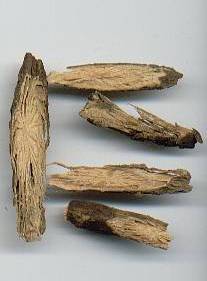
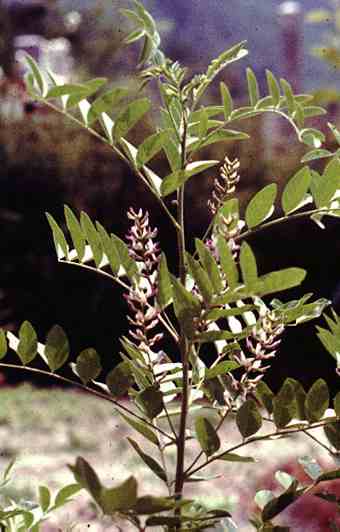 Plant
family Fabaceae (bean family) Sensoric quality The aroma is strongly
reminiscent of anis or fennel, but considerably stronger. The taste
is dominantly sweet, warm and medical. Main constituents The root,
especially the root bark, contains about 4% glycyrrhizin, the potassium
or calcium salt of glycyrrhizinic acid. The latter is a glycoside
of a pentacyclic triterpene carboxylic acid (18ß-glycyrrhetic
acid) with two molecules glucuronic acid. Glycyrrhizin is about
50 times sweeter than sucrose (cane sugar). Furthermore, a flavonoid
glycoside has been identified: liquiritin. The aglycon liquiritigenin
is in part spontaneously formed when the root is dried; it is responsible
for the spasmolytic effects of licorice. Licorice contains only
traces of essential oil; constituents identified include bicyclic
monterpenoid ketones (fenchone, thujone) and coumarins (herniarin,
umbelliferone).
Plant
family Fabaceae (bean family) Sensoric quality The aroma is strongly
reminiscent of anis or fennel, but considerably stronger. The taste
is dominantly sweet, warm and medical. Main constituents The root,
especially the root bark, contains about 4% glycyrrhizin, the potassium
or calcium salt of glycyrrhizinic acid. The latter is a glycoside
of a pentacyclic triterpene carboxylic acid (18ß-glycyrrhetic
acid) with two molecules glucuronic acid. Glycyrrhizin is about
50 times sweeter than sucrose (cane sugar). Furthermore, a flavonoid
glycoside has been identified: liquiritin. The aglycon liquiritigenin
is in part spontaneously formed when the root is dried; it is responsible
for the spasmolytic effects of licorice. Licorice contains only
traces of essential oil; constituents identified include bicyclic
monterpenoid ketones (fenchone, thujone) and coumarins (herniarin,
umbelliferone).
Other plants containing thujone:
Salvia officinalis L. - Sage (Leaf)
Salvia triloba L. - Greek Sage (Plant)
Artemisia dracunculus L. - Tarragon (Shoot)
Mentha x rotundifolia (L.) HUDSON - Applemint (Leaf)
Pycnanthemum tenuifolium SCHRAD. - Slenderleaf Mountain Mint (Shoot)
Mentha pulegium L. - European Pennyroyal (Plant)
Thymus orospedanus H. del VILLAR - Orosped Thyme (Plant)
Achillea millefolium L. - Yarrow (Plant)
Capsicum frutescens L. - Cayenne (Fruit)
Carum carvi L. - Caraway (Fruit)
Glycyrrhiza glabra L. - Licorice (Root)
Juniperus sabina L. - Sabine (Plant)
Matricaria recutita L. - Annual Chamomile (Plant)
Mentha arvensis L. - Cornmint (Plant)
Sassafras albidum (NUTT.) NEES - Sassafras (Root)
Satureja hortensis L. - Summer Savory (Plant)
Want to talk with the Fairy about
this absinthe recipe or else?
Write to greenfairy (at) msjekyll (dot) com anytime...


More @ MsJekYll.com » Axis | Absinthe & the Green Fairy | Poetry | The Mayfair Witches | Site Map
Other good sitez:

Want to know how to make absinthe at home?
Try Absolutely Absinthe kit.

Absinthe Chemistry & Recipe
at About.com





